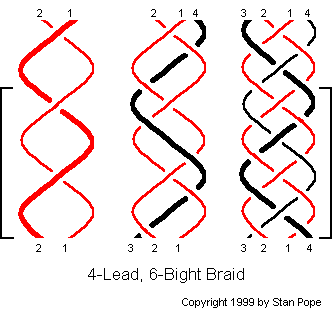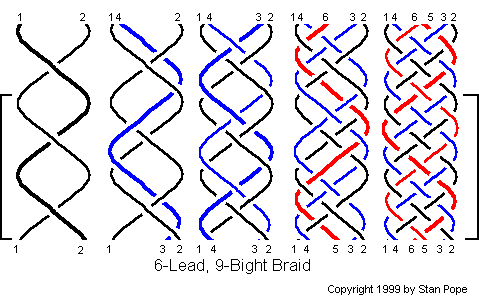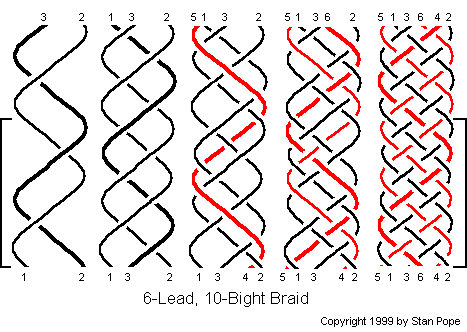
In the companion page, Woggles, Turk's Head Knots, and Other Single-Strand Braids, I presented families of braid knots that can be tied with a single strand. While four-lead knots with 4N+1 and 4N+3 bights are readily formed with a single strand, the other four-lead knot families, 4N and 4N+2 bights, were absent. They can not be tied with a single strand.
The purpose of this page is to "fill in the gaps," so to speak ... to provide construction details for the other families of simple braid knots. (I have excluded diagrams for the cases in which the number of bights is a multiple of the number of leads. In these cases, each lead must be a separate strand, e.g. Four leads and four, eight, twelve, etc. bights requires four separate strands.)
When the number of leads and the number of bights are not mutually prime, the knots can still be formed, but additional strands are needed. If different colors are used for each strand, then the effect can be quite pleasing.
Technically, these are knots, not braids, because braids are composed of separate interwoven strands. None-the-less, "braid" seems a most descriptive word for the beauty of this family of knots.
If you find the information in this page useful, please drop a dollar or two in an envelope and send it to my Boy Scout Council at Friends of Scouting, W.D. Boyce Council, BSA, 614 N.E. Madison, Peoria, IL, 61603. It will help my council and us volunteers continue to deliver "Good Scouting" to the youth of our area.
I would like to hear how you use the information. Please drop me
an
Please refer to the descriptions on the companion page, Woggles, Turk's Head Knots, and Other Single-Strand Braids.
The diagrams show the braid cut across and flattened. If it helps you visualize better, cut one out and roll it into a cylinder so that the numbers are connected.
The numbers at the bottom identify the "passes" involved in forming the braid. "1" is the first lead, and always consists of a simple wrap. "2" is the second lead, and may be more complex.
The numbers at the top of the diagram show the match-up of the lead for the next pass.
Braiding progresses from bottom of the diagram toward the top. When the top is reached, braiding continues from the bottom of the next braid picture to the right.
The diagrams show the current lead in a heavy line. When a lead passes under another, it is shown with a gap; When a lead passes over another, the other is shown with a gap.
The repeating section of the braid is marked by margin bars. This section may be included zero or more times on each wrap to make other members of that family. For instance, if the repeating section of the 4-lead, 6-bight (4n+2) braid is included twice on each wrap, the result is a 4-lead, 10-bight braid. It still requires two separate strands to construct.

Two color.

Two color.

Three color.

Two color.
Top | Woggles, Turk's Head Knots, and Other Single-Strand Braids
Latest update: 9/18/2008 to replace malformed GIF files
Copyright 1999, 2008 © by Stan Pope. All rights reserved. (Permission will probably be given, on request, to reproduce this material for use in Cub Scout or Boy Scout programs.)